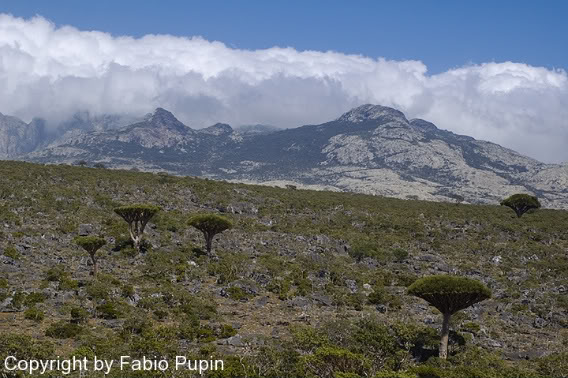Lying in the Indian Ocean half way between Somalia and Yemen, the strange island archipelagos of Socotra offer a bewildering array of life found no where else on Earth. Thirty seven percent of its plant species, ninety percent of its reptiles, and ninety-five percent of its snail species are endemic.
Now biologists can add a new species to this list. Italian researchers unraveled the mystery of a gecko named Hemidactylus inintellectus (photo below). Inintellectus translates to ‘misunderstood’, since the gecko, which is common on the island, was consistently confused with other species.
“This new discovery raises the number of reptile species of Socotra to 26, with 23 species endemic of the island. And this is not a mere matter of numbers: when a species has no name it doesn’t exist, and it can’t be protected. That’s why biodiversity assessments are such an essential tool for conservation policies,” writes one of the researchers, herpetologist Fabio Pupin of the University of Pavia.
According to Pupin, Socotra is a reptile’s paradise (there are no amphibians on the island): “[Reptiles] are everywhere, from the high mountains of Haggeher to the desert lowland of the south coast, basking on tree branches as on nearly every rock around—and Socotra is a rocky place indeed! And even underground: there are, in fact, five worm-like reptiles, suited to a completely ctonian life.”
The new species of gecko prefers rocky areas and is nocturnal.
For more information and photos visit Herpfolio.

New gecko species from Socotra:Hemidactylus inintellectus. Photo by: Fabio Pupin.

Something out of science fiction? The Socotra seaside. Photo by: Fabio Pupin.

Mountains and trees of Socotra. Photo by: Fabio Pupin.
Related articles
New species everywhere in Papua New Guinea’s ‘lost’ volcano

(09/07/2009) A five week expedition into a remote extinct volcano has uncovered a treasure trove of new species in Papua New Guinea, including what may be the world’s largest rat, a fanged frog, and a grunting fish. In all the expedition estimates it may have found around forty species unknown to science. The expedition was undertaken by a BBC film crew and scientists in January. Local trackers led them into the unexplored jungle, hidden beneath the Bosavi volcano’s 2,800 meter summit. Six months prior to arrival, fields of spinach and sweet potato were planted to feed the expedition in such a remote area.
Photos: hundreds of new species discovered in Himalayan region, threatened by climate change

(08/10/2009) Scientists from a variety of organizations have found over 350 new species in the Eastern Himalayas, including a flying frog, the world’s smallest deer, and a gecko which has walked the earth for 100-million-years, according to a new report by the World Wildlife Fund (WWF). The report, entitled Where World’s Collide, warns that these rare biological treasures, as well as numerous other species, are threatened in the Eastern Himalayas by climate change.
Photo: Scientists discover new species of Komodo dragon-like lizard
(07/21/2009) German researchers have discovered a new species of monitor lizard in Indonesia using DNA analysis and morphological characteristics. The species, Varanus lirungensis, is described in the Australian Journal of Zoology.
Photo: Salamander is first 4-legged animal discovered in U.S. in 50 years
(07/09/2009) Researchers have discovered one of the world’s smallest salamanders in a road-side creek in Georgia. The amphibian is so unique that it represents the first new genus of four-legged animal discovered in the United States in 50 years.
Photos: treasure trove of new species discovered in Ecuador

(06/16/2009) Near the once-contentious border of Ecuador and Peru in the mountainous forests of the Cordillera del Condor, scientists from Conservation International (CI) conducted a Rapid Assessment Program (RAP), uncovering what they believe are several new species, including four amphibians, one lizard, and seven insects. The team focused on the Upper Nanharitza River Basin, which has been geologically isolated from the rest of the Andes, giving it broad potential for new species.
Photos: new gecko discovered on bizarre and beautiful Socotra island

(09/10/2009) Lying in the Indian Ocean half way between Somalia and Yemen, the strange island archipelagos of Socotra offer a bewildering array of life found no where else on Earth. Thirty seven percent of its plant species, ninety percent of its reptiles, and ninety-five percent of its snail species are endemic. Now biologists can add a new species to this list. Italian researchers unraveled the mystery of a gecko named Hemidactylus inintellectus. Inintellectus translates to ‘misunderstood’, since the gecko, which is common on the island, was consistently confused with other species.







